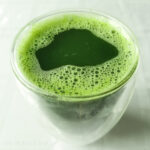
How to Make Pandan Juice and Pandan Extract
Servings: 1 cup (240g)
Calories: 10kcal
Cost: $1.10
Make pandan juice and pandan extract from scratch using fresh or frozen leaves! Pandan adds flavour to many Southeast Asian recipes.
Print Recipe
Equipment
- High speed blender (such as Vitamix or Blendtec)
- Nut milk bag (or metal fine-mesh strainer)
Ingredients
- 1 cup chopped pandan leaves (see Note 1
) - 1 cup water
Instructions
Unstrained Pandan Juice
- Rinse each pandan leaf thoroughly. Pandan is a little like leek in that they can hide a lot of dirt in between the leaves, especially towards the stem near the bottom.
- Add the rinsed leaves along with 1 cup water to a blender. Blend on high speed until very smooth. You may need to scrape down the sides a few times.
- Pour the blended juice through a nut milk bag or fine-mesh strainer into a container. I find using a nut milk bag to be a little faster, plus it allows me to wring more juice out of the pandan pulp. But a metal strainer works too; just work in batches and press down on the pulp with the back of a spoon to extract as much juice as possible.
- You can use this strained pandan juice to make recipes with higher water content, such as Onde-Onde, Buko Pandan, Cendol, Pandan Coconut Jelly, and Kuih Seri Muka, or use it to flavour rice. Depending on the recipe, you can also swap out part of the liquid in a recipe for pandan juice. If you want a more intense green colour, you should make pandan extract instead, instructions below.
Pandan Extract
- Follow the instructions for Strained Pandan Juice. Leave the strained juice in the fridge for 48 hours, undisturbed, in an airtight jar.
- After 48 hours, you’ll notice the pandan juice has separated into a colour gradient: the bottom layer is a darker green due to the settling of the chlorophyll pigments in the juice. Pour off the pale liquid at the top and you are left with the darker concentrated stuff at the bottom, which is the extract (see Note 2). 1 cup of pandan juice yields roughly 2 tbsp of pandan extract through this method. You can use this pandan extract to add colour to baked goods, such as this
Pandan Coconut Loaf .
Notes
- 1 cup (50g) of chopped pandan is roughly equivalent to 10 leaves, however, the sizes of individual leaves varies which is why I prefer a weight measurement. Pandan leaves should be chopped into segments no longer than 2 inches. The smaller the pieces, the easier they are for the blender to pulverize.
- Because we are making pandan juice from pandan leaves with no artificial flavourings or colours, it will be hard to concentrate the product enough to match commercial pandan extract. You will need to use more of the homemade extract than storebought extract. As a rule of thumb, for every 1 tsp of storebought pandan extract called for in a recipe, use 1 tbsp of homemade pandan extract.
Nutrition
Calories: 10kcal | Carbohydrates: 2g | Protein: 1g | Fat: 0.1g | Sodium: 69mg | Potassium: 156mg | Fiber: 1g | Vitamin A: 3150IU | Vitamin C: 28mg | Calcium: 46mg | Iron: 1mg